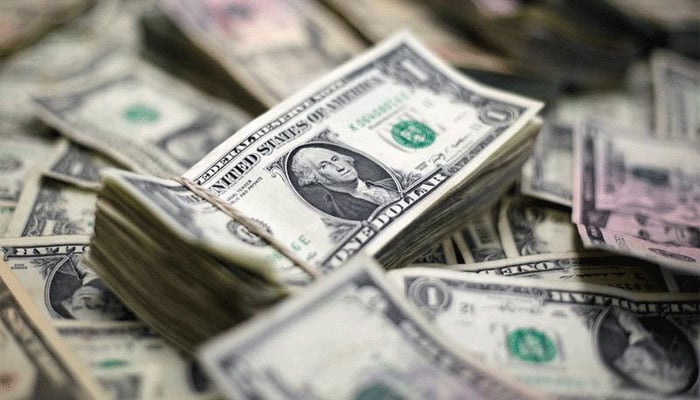Net International Reserves nosedive massively in three months
The IMF envisages NIR held by the State Bank of Pakistan (SBP) as quantitative performance criteria and indicative target under the $6 billion bailout package of Extended Fund Facility (EFF)
ISLAMABAD: Pakistan’s Net International Reserves (NIR) have plunged into negative territory during the last three months, indicating clearly that the severity of the crisis is beyond the imagination of even policymakers.
The IMF envisages NIR held by the State Bank of Pakistan (SBP) as quantitative performance criteria and indicative target under the $6 billion bailout package of Extended Fund Facility (EFF). “In the last three months, the NIR went down negative in a big way,” said one top official but declined to share its exact figures. The NIR is a measure of total gross reserves held by the SBP and excludes the liabilities and repayments due within the envisaged period. On eve of the last review under the IMF programme, it was envisaged that the NIR stood at negative $4 billion in June 2021.
Till the end of September, the NIR was estimated negative $2.1 billion. The official said that the severity of the crisis possessed multiple aspects, including higher POL and commodities prices in the international market, conflicts between Russia and Ukraine, a fluid domestic political environment and policy inaction of government multiplied and aggravated the prevailing economic situation.
UK-based Pakistani economist Yousuf Nazar, when inquired about severity of lingering crisis faced by Pakistan, said that the Brent crude oil is $111 a barrel or Rs134 a litre. This is just the cost of crude. “No option but to increase the petrol price and go to the IMF. The other option is default, bankruptcy, massive devaluation which will result in a sharp rise in inflation,” he added.
He said that the fundamental objectives of five-point plan include stabilisation, reform, equity and growth by removing distortions in taxes, pricing, and incentives, so resources are put to productive use for export-oriented growth, greater industrialisation, and the creation of more jobs.
When contacted, Dr Khaqan Najeeb, former adviser, Ministry of Finance, said due to a lack of a fundamental reform of economy, Pakistan has been pushed in several balance of payment crises since its birth. However, the current Balance of Payment Crisis is different from the previous ones. The constellation is far more concerning.
The political atmosphere is much more charged with ongoing protests and jalsas both by the opposition as well as the government. There is less clarity on lingering uncertainty of the time period of next elections. Global environment is less helpful with rising commodity prices, slowing economic growth and rising inflation. If all this was not already overwhelming, the issues in the economy and energy sector are far more complex and there appears to be a lack of home-grown solutions.
He commented that the result of delay in action is that rupee continues to struggle, the country’s default risk as measured by five-year credit-default swaps is at the highest since 2013, and the six-month KIBOR is at 14.25 percent – the highest in 13 years – while treasury bills rates are approaching 15 percent, the highest in 24 years. Needless to mention, the SBP reserves have fallen to just 10.3 billion dollars.
The task at hand is tremendous – build the SBP foreign exchange reserves and present a budget when revenues are scarce but people are looking for spending that helps them. He explained the higher cost of energy in Pakistan is driven by the global commodity super cycle and further affected by the effect of rupee adjustment. The biggest task is revising prices, which is essential to signal to curtail oil consumption that is up 20pc in April and consequently the large import bill. In this backdrop, energy pricing policy in Pakistan needs to be prudent enough to curtail the subsidy burden on the exchequer, yet savvy to convince the IMF and also look after the citizens reeling under inflationary pressures.
-
 Kate Middleton Celebrates England Women's Rugby Stars After World Cup Win
Kate Middleton Celebrates England Women's Rugby Stars After World Cup Win -
 Kris Jenner Dubs Chicago West Her 'sweet Angel' As She Turns Eight
Kris Jenner Dubs Chicago West Her 'sweet Angel' As She Turns Eight -
 Josh Charles Credits Taylor Swift For His, Ethan Hawke’s Moon Person Trophies
Josh Charles Credits Taylor Swift For His, Ethan Hawke’s Moon Person Trophies -
 Jodie Foster Voices Opinion About 'misogyny'
Jodie Foster Voices Opinion About 'misogyny' -
 Virginia Madsen Remembers Late Brother Michael Madsen Six Months After His Death
Virginia Madsen Remembers Late Brother Michael Madsen Six Months After His Death -
 Emilia Clarke Reveals Real Price Of Playing Daenerys In 'Game Of Thrones'
Emilia Clarke Reveals Real Price Of Playing Daenerys In 'Game Of Thrones' -
 Ex-Chicago Mayor Hit With Lawsuit Over Unpaid Credit Card Bills
Ex-Chicago Mayor Hit With Lawsuit Over Unpaid Credit Card Bills -
 Andrew Risks His Relationships With Princess: ‘She’s Supporting The Abused And It’s Festering’
Andrew Risks His Relationships With Princess: ‘She’s Supporting The Abused And It’s Festering’ -
 Harry Styles Unveils New Album After Cryptic Posters Spark Fan Frenzy
Harry Styles Unveils New Album After Cryptic Posters Spark Fan Frenzy -
 Prince Harry Ready To Return To The UK To King Charles But It’ll Depend On How THIS Goes
Prince Harry Ready To Return To The UK To King Charles But It’ll Depend On How THIS Goes -
 Why Isn't King Charles Mourning Death Of His Father's First Cousin?
Why Isn't King Charles Mourning Death Of His Father's First Cousin? -
 Nicole Richie Breaks Silence On Her Daughter's Name Change
Nicole Richie Breaks Silence On Her Daughter's Name Change -
 Truth Behind Chris Noth, Sarah Jessica Parker's Ongoing Feud Revealed
Truth Behind Chris Noth, Sarah Jessica Parker's Ongoing Feud Revealed -
 Baseless Gender Identity Rumors Targeted At Bettijo Hirschi After Todd Bridges Split
Baseless Gender Identity Rumors Targeted At Bettijo Hirschi After Todd Bridges Split -
 'Harry Potter' TV Series Roped In Hans Zimmer For Score
'Harry Potter' TV Series Roped In Hans Zimmer For Score -
 Amy Robach, T.J. Holmes Make Daring Invite To Exes Marilee, Andrew
Amy Robach, T.J. Holmes Make Daring Invite To Exes Marilee, Andrew




